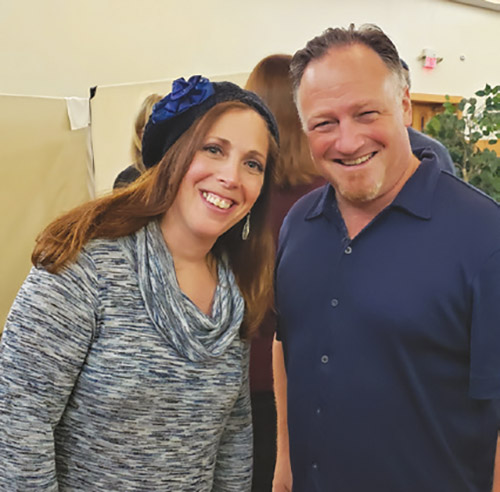

They came to support their community mikvah and left with a better understanding of the history of some of their favorite foods.
Dozens of community members came out to participate in a wine and dessert event at the Stephanie Thea Shatkin Mikvah at the Young Israel of East Brunswick (YIEB) on Sunday evening, November 7. The event featured noted Jewish food researcher Joel Haber. Socially distanced seating was in place and Zoom viewing options were available for those who preferred.
Claire Kagel, mikvah president, welcomed attendees and thanked the YIEB adult education committee for co-sponsoring the event.
YIEB’s Rabbi Joshua Hess noted that in Parshat Vayeitzei, Yaakov runs away from his brother and falls asleep in what he later realizes is a holy place. How could he not know? Like many of us, we see the beauty of things—like our synagogue and mikvah—and take for granted how they got that way. Rabbi Hess then gave special thanks and acknowledgement to the women who spent the entire day cleaning the mikvah. Now that we know who is responsible, we should show appreciation—as Yaakov showed appreciation once he knew where he was.
Haber began by noting that he made aliya and has been working as a Jerusalem-based tour guide for about 10 years. His research into the history of food as part of Jewish culture led to the creation of his particularly popular food tour of the Machane Yehuda market, which further fueled his interest and research. He is currently working on a book of global cholent to trace the migration of Jews and food influences.
Although Jews have been minorities in most of the countries in which they lived, their outsize influence on foods is apparent. Jews had the monopoly on the spice trade for several centuries as the easily transportable, lightweight commodity brought high prices at the final destination.
Another major food transport involved sugar as a cultivated crop.
Cultivated sugar was very expensive, with the Middle-Eastern sweeteners from honey or dates not easily transportable. Sugar needed a specific climate to thrive, and crypto-Jews left for Brazil and Suriname when forced to leave Spanish and Portugal. Their remaining family connections with those who moved deeper into Europe made it easier to create the channels necessary to export sugar to Europe.
Haber introduced the “gefilte line” on a map of Europe. One side of the map showed areas where sugar was readily available and residents of these areas favored sweet gefilte fish and sweeter kugels. Residents of the other side relied on savory dishes because of the lack of sugar.
He noted that the Jews of Curacao began as middlemen for the chocolate trade, which they exported in addition to sugar to their brethren in Amsterdam. Chocolate moved into France via the Jews in the southern areas who maintained contacts with the conversos just over the border in Spain. Conversely, foods like sugar beets became popular in the New World.
Haber shared an overlay map of early settlements of Jews and the growth of citrus in the Mediterranean area. While most foods were transported for their economic feasibility, Jews began citrus orchards due to the need for an etrog for Sukkot. Once they were growing one type of citrus, they added oranges, lemons, etc., for year-round profitability.
Haber provided further examples of the Jewish influence on the coffee trade and how certain foods were named for and/or influenced by Jewish eating practices. A Jewish man is credited for the British dish of fish and chips. Frying fish in oil was uniquely a Jewish practice, as most Brits would have used lard. The potatoes were an add-on. The French foie gras industry was also influenced by the Jews as a substitute for oil was needed. Olive trees were not available, and lard was obviously not an option. Goose fat, however, was the answer. Interestingly, there is rabbinic literature of the time questioning the appropriateness and acceptability of force-feeding geese.
The uber-Mexican dish of chili con carne may also be the result of converso Jews fleeing to South and Central America and missing their cholent. The classic avgolemono may also have roots in Jewish cuisine brought to Greece by Sephardic Jews who needed a pareve way to thicken soups and used the now-popular egg and lemon juice mixture.
Ellen Rabinowitz of East Brunswick was glad she came. “There is a whole history to learn about; looking at where food comes from brings new meaning to it.” Debbie Wasserman, one of the event organizers, enjoyed the presentation: “I learned about so many aspects of the origins of our foods.”
For more information about upcoming events at YIEB, visit https://www.yieb.org/.
By Deborah Melman










